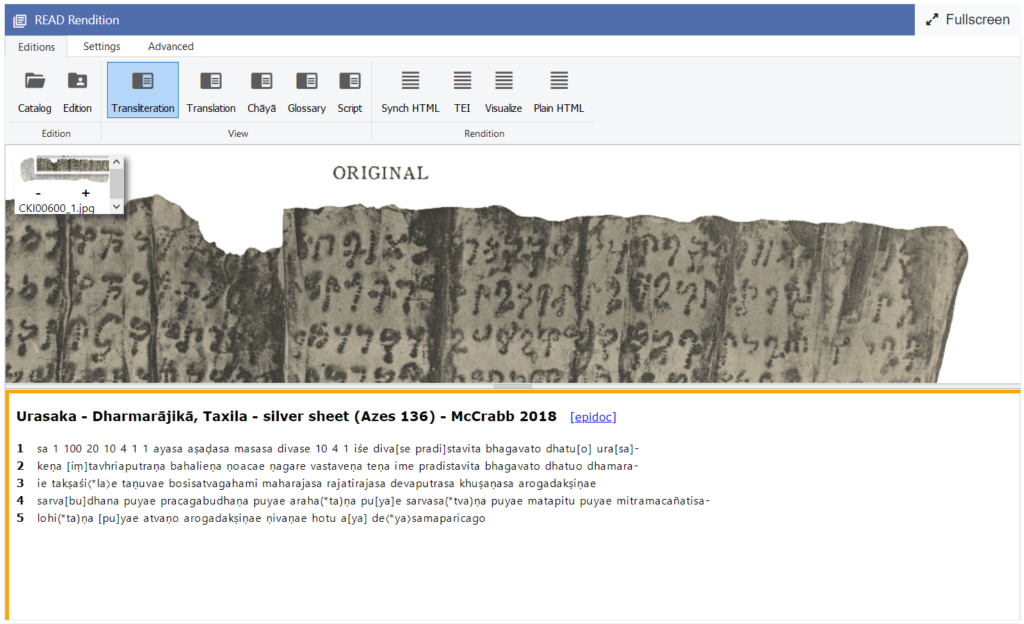This stone cylinder casket is currently located in a private collection in Tokyo. The initial edition by Fussman was based on photographs facilitated by an antiquities dealer with the permission of the owner. Subsequent editions by Falk, Baums and the current edition have been based on the photographs printed in the Fussman edition. Based on an image of the entire casket it is clear that the inscription is engraved on the bottom of the base, as the inscribed surface is circular without any groove or rim.
Conventional Name Kopśakasa reliquary | Item cylindrical stone casket | Surface Base | Collection Private | Current Location Tokyo | Language/Script Gāndhārī/Kharoṣṭḥī
Content Summary
The great king Kopaśakasa establishes relics of Śākya sage (which are pervaded be wisdom, virtue, concentration and understanding) in Tramaṇa. Based on these relics there is liberation from immeasurable suffering.
Keywords
Benefit, Buddha, EraRulerDate, Establishment
Previous Editions
-
Fussman, Gerard. 1984. “Nouvelles inscriptions śaka (II).” Bulletin de l’École française d’Extrême‐Orient 73: 31–46
-
Falk, Harry. 2010. “Signature Phrases, Azes Dates, Nakṣatras and Some New Reliquary Inscriptions from Gandhāra.” Sōka daigaku kokusai bukkyōgaku kōtō kenkyūjo nenpō創価大学国際仏教学高等研究所年報 13: 13–33.
-
Baums, Stefan. 2012. “Catalog and Revised Texts and Translations of Gandharan Reliquary Inscriptions.” In: David Jongeward, Elizabeth Errington, Richard Salomon and Stefan Baums, Gandharan Buddhist Reliquaries. Gandharan Studies, Volume 1, Seattle: Early Buddhist Manuscripts Project. 222-3
Other References
-
Bibliographic details of references to this inscription are available from
(
Gāndhārī Language and Literature
)
Acknowledgements
Research on this edition and production of the digital edition was completed with the generous support of the Prakaś Foundation. The transliteration, translation, chāyā and glossary have been reviewed by Mark Allon and Stephanie Majcher.
Digital publishing by Ian McCrabb
Each digital edition includes background information about the text, a summary of its content, and references to parallel texts and related publications. Users can explore the text, image, and other analysis resources through various preset views from the READ interface, or customize the views themselves.
By developing the text in READ, the text and image are linked such that selecting a syllable, word, or compound in the text or glossary will highlight the associated akṣaras on the manuscript. This allows you to in effect “read” the manuscript as you read the transcribed text, even if you do not know the script.
Users can choose from several preset READ views by selecting the tabs at the top. Each of these convenient arrangements of text and resources is suited to a different experience with the manuscript. For instance, choose the Script view to study the paleography of the manuscript or the Glossary view to study its vocabulary. It is recommended that the user toggles through the default views to gain a holistic perspective of the text.

- Transliteration: Image and transliteration.
- Translation: Transliteration and translation.
- Chāyā: Transliteration and chāyā.
- Glossary: Image, transliteration, and glossary.
- Script: Image, transliteration, and script chart
- Visualize: Visualize the text structure display.
- Synch HTML: Interactive synchronized rendition.
- TEI: EpiDoc TEI rendition.
- Plain HTML: Transliteration in HTML format.
Avś
Be
Ce
Ch.
CPS
DhG
Ee
FJJ
Mahīś
MūSā
Mvu
P
SĀ
SBhV
Se
Skt.
SN
T
Tib.
Vin
Avadānaśataka (ed. Speyer 1906–1909)
Burmese (Chaṭṭhasaṅgāyana) edition
Sri Lankan (Buddha Jayanti Tipiṭaka Series) edition
Chinese
Catuṣpariṣat-sūtra (ed. Waldschmidt 1952–1962)
Dharmaguptaka
European (Pali Text Society) edition
Fobenxing ji jing (T 190)
Mahīśāsaka
Mūlasarvāstivāda
Mahāvastu-avadāna (ed. Senart 1882–1897)
Pali
Saṃyukta-āgama (T 99)
Saṅghabhedavastu (ed. Gnoli 1977–1978)
Thai (King of Siam) edition
Sanskrit
Saṃyutta-nikāya
Taishō 大正 edition
Tibetan
Vinaya

